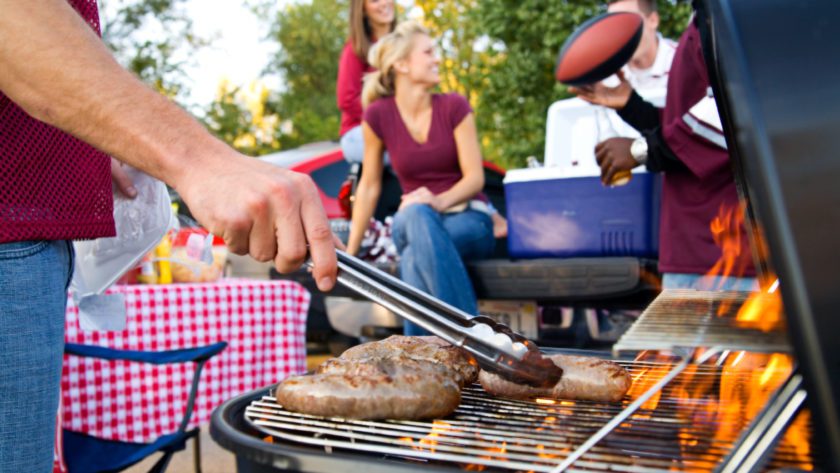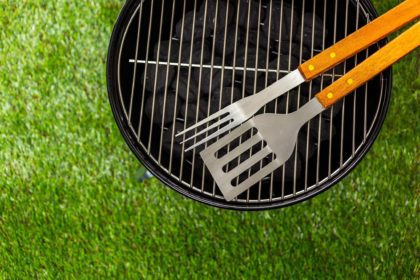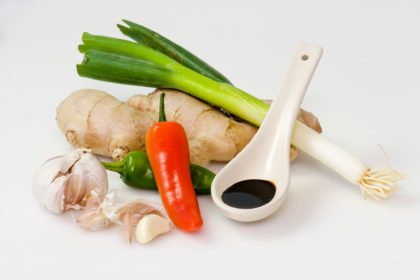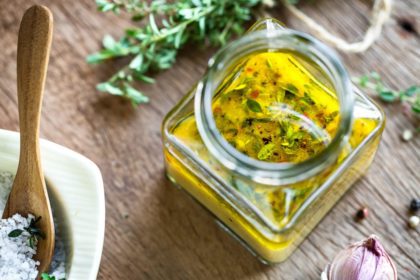Football and baseball are synonymous with tailgate parties, cooking outdoors, and picnics. That means you’ll need to pay special attention to menu planning, preparation, and safe food handling practices. Since you’re without a refrigerator and running water, here’s how to keep your food safe all day.

What to Pack

- Lots of clean utensils for preparing and serving safely cooked food.
- Insulated coolers to keep food protected and cold OR hot.
- A meat thermometer to be sure meat and poultry are cooked at high enough temperatures to destroy harmful bacteria and foods are reheated to safe-to-eat temperatures.
- A fridge and freezer thermometer for coolers.
- An oven thermometer for hot insulators.
- An instant-read thermometer for reheating leftovers.
- Clean, wet, disposable cloths, hand sanitizer, and paper towels for cleaning hands and surfaces.
- Disposable gloves for cleaning or touching raw meat.
- Smaller containers or foil for leftovers.
- Water for cleaning.
The “Danger Zone”: 41ºF to 135°F
Keep Cold Foods Cold
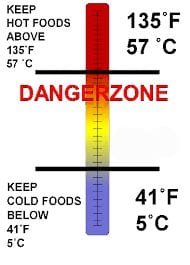 Place a fridge and freezer thermometer in your cooler. Be sure your food stays BELOW 41ºF.
Place a fridge and freezer thermometer in your cooler. Be sure your food stays BELOW 41ºF.- Cold food should be stored in a well-chilled cooler.
- Do not leave the food out for more than two hours (one hour if weather is above 90ºF).
- Keep food in the shade and out of the sun.
- Keep perishable cooked food, such as luncheon meat, cooked meat, chicken, and potato/pasta salads “refrigerator cold”, so keep it next to the ice.
Keep Hot Foods Hot
- Do NOT partially cook meat or poultry at home ahead of time, then transport the half-cooked food to the party/picnic. Doing so allows harmful bacteria to thrive and multiply.
- Hot foods like chili, soup and stew need to stay hot. Be sure your hot foods stays at ABOVE 135ºF to stop any germs from growing.
- Stir food to help keep the food on top hot. A cover on the pan helps to keep the heat inside.
- To transport and store piping hot foods, use an insulated container* like a cooler.

*How to prepare a hot insulator:
- Heat up some hot bricks. Wrap them in heavy-duty foil first, then heat up in a 300 degree oven for at least 30 minutes.
- In the meantime, warm up your insulator (e.g., a cooler): Fill it with boiling water, let stand for a few minutes, and empty.
- Place newspaper and brown paper grocery bags on the bottom to insulate.
- Add your hot bricks.
 Line the insulator with thick towels to further insulate and prevent melting the plastic if inserting a hot pot off the stove.
Line the insulator with thick towels to further insulate and prevent melting the plastic if inserting a hot pot off the stove.- Place an oven thermometer in the insulator to ensure it stays hot enough.
- Keep the insulated container closed and the food should stay hot (136º or above) for the whole game.

When to Discard Food
Foods left in the Danger Zone for more than four hours must be discarded. Reheating the food may kill the bacteria, but it won’t kill the toxins produced by the bacteria. The toxins remain the the food and can cause foodborne illnesses.
How to Cool Large Pots of Hot Food
If you’re cooking hot food the night before (e.g., a pot of chili), it needs to be refrigerated after cooking. WARNING: Food needs to chill quickly to avoid bacteria growth during the cooling process. To do so, separate into smaller containers and set the containers in an ice bath. When cool, refrigerate.
Handling Raw Meat, Poultry and Fish
- Cooking raw meat is risky unless all food handlers are diligent about keeping utensils, hands and surfaces clean to prevent cross-contamination.

- If transporting perishable raw meat (e.g., hamburger patties, sausages, chicken, fish), place it in an insulated cooler packed with several inches of ice, frozen gel packs, or containers of ice.
- Wrap raw meat securely to prevent juices from cross-contaminating ready-to-eat food. Ideally, keep these raw foods in a separate cooler.
- Use a meat thermometer to measure internal cooking temperatures.

Remember… a cooler is not a refrigerator. Keep the most perishable items next to the ice.
Safe minimum internal temperatures:
- Beef, pork, lamb, veal steaks, roasts, chops, seafood (145ºF)
- Ground meats (160ºF)
- Poultry (165ºF)
- Leftovers (165ºF)
NOTE! If cooking marinated raw meat at the tailgate site, be sure not to reuse the marinade unless it’s boiled first to destroy harmful bacteria. Be sure cooked food is placed on a clean platter free of any raw meat juices.
Keep hot foods hot and cold foods cold.
![]() Karen’s Fit Tip: If you can’t keep the food hot while transporting it to the picnic/tailgate party site, cook the food the night before, and cool it in the refrigerator. On the day of the party/picnic, pack the food in a well-chilled cooler and reheat it to 165ºF on a camping stove.
Karen’s Fit Tip: If you can’t keep the food hot while transporting it to the picnic/tailgate party site, cook the food the night before, and cool it in the refrigerator. On the day of the party/picnic, pack the food in a well-chilled cooler and reheat it to 165ºF on a camping stove.


